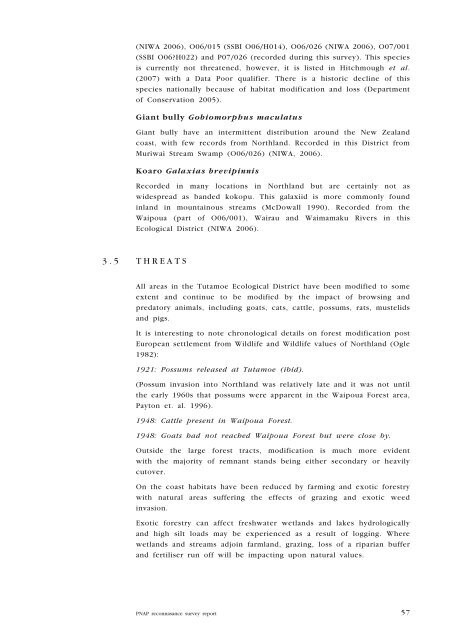Natural areas of Tutamoe Ecological District (3. Ecological character)
Natural areas of Tutamoe Ecological District (3. Ecological character)
Natural areas of Tutamoe Ecological District (3. Ecological character)
Create successful ePaper yourself
Turn your PDF publications into a flip-book with our unique Google optimized e-Paper software.
(NIWA 2006), O06/015 (SSBI O06/H014), O06/026 (NIWA 2006), O07/001<br />
(SSBI O06?H022) and P07/026 (recorded during this survey). This species<br />
is currently not threatened, however, it is listed in Hitchmough et al.<br />
(2007) with a Data Poor qualifier. There is a historic decline <strong>of</strong> this<br />
species nationally because <strong>of</strong> habitat modification and loss (Department<br />
<strong>of</strong> Conservation 2005).<br />
Giant bully Gobiomorphus maculatus<br />
Giant bully have an intermittent distribution around the New Zealand<br />
coast, with few records from Northland. Recorded in this <strong>District</strong> from<br />
Muriwai Stream Swamp (O06/026) (NIWA, 2006).<br />
Koaro Galaxias brevipinnis<br />
Recorded in many locations in Northland but are certainly not as<br />
widespread as banded kokopu. This galaxiid is more commonly found<br />
inland in mountainous streams (McDowall 1990). Recorded from the<br />
Waipoua (part <strong>of</strong> O06/001), Wairau and Waimamaku Rivers in this<br />
<strong>Ecological</strong> <strong>District</strong> (NIWA 2006).<br />
<strong>3.</strong>5 THREATS<br />
All <strong>areas</strong> in the <strong>Tutamoe</strong> <strong>Ecological</strong> <strong>District</strong> have been modified to some<br />
extent and continue to be modified by the impact <strong>of</strong> browsing and<br />
predatory animals, including goats, cats, cattle, possums, rats, mustelids<br />
and pigs.<br />
It is interesting to note chronological details on forest modification post<br />
European settlement from Wildlife and Wildlife values <strong>of</strong> Northland (Ogle<br />
1982):<br />
1921: Possums released at <strong>Tutamoe</strong> (ibid).<br />
(Possum invasion into Northland was relatively late and it was not until<br />
the early 1960s that possums were apparent in the Waipoua Forest area,<br />
Payton et. al. 1996).<br />
1948: Cattle present in Waipoua Forest.<br />
1948: Goats had not reached Waipoua Forest but were close by.<br />
Outside the large forest tracts, modification is much more evident<br />
with the majority <strong>of</strong> remnant stands being either secondary or heavily<br />
cutover.<br />
On the coast habitats have been reduced by farming and exotic forestry<br />
with natural <strong>areas</strong> suffering the effects <strong>of</strong> grazing and exotic weed<br />
invasion.<br />
Exotic forestry can affect freshwater wetlands and lakes hydrologically<br />
and high silt loads may be experienced as a result <strong>of</strong> logging. Where<br />
wetlands and streams adjoin farmland, grazing, loss <strong>of</strong> a riparian buffer<br />
and fertiliser run <strong>of</strong>f will be impacting upon natural values.<br />
PNAP reconnasance survey report<br />
57

















